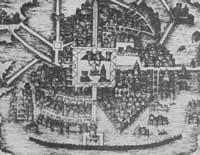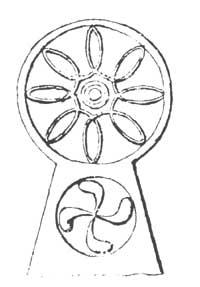Aztecs and Beans
1989/10/01 Zabala Lekue, Eduardo Iturria: Elhuyar aldizkaria
Aztecs
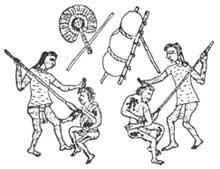
The most important city of this village was built in 1320: Tenotxtitla was the most important of Mexico's current ravine. To reach the city of Tenotxtitla, the Aztecs slowly moved south of the territories in which the Colorado River is located after about 300 years, until reaching the current lake of the Mexican capital. On this trip, the ancestors of the village (toltekar, olmdakar, zapotecos) built other villages with different functions: TOS (administrative people) and MITLA (people of death). Azteka means: “People with an unknown face.”
They lived as nomads and mercenaries, considered barbarians by the other “civilized” peoples of the Mexican ravine. By 1500 they were the most powerful in the area, dominated and assimilated by the culture, beliefs and social structures of other peoples. With the Moktezuma, the philosopher king, they achieved the culmination of their culture and the disaster that would occur with the arrival of the Spanish. Why should the ancestors of the Aztecs abandon the rich and fertile lands surrounding the Colorado River through a desert for so many years? His mythology gives us some clues.
Jewish/Israeli

The history of this village is probably better known and seems to be that at the time of the sons of Jakob, i.e. a. C. In 1700, HIKSOS was annexed in its migration to the Egypto of the time, with which Judu-Herria consolidated as a collaborator. There they lived 600 years and when the people of Egypto managed to send hiksostarras, the Jews did not go with them. But the Egyptians saw them and that's why they had to do massive and heavy works in the gigantic buildings of Ramsese.
Crossing the freedom of this country and the Red Sea, they reached Transjordan, the territory of Kanaa, offered by their God Yahweh. According to some theories, the Jews who lived there at the beginning of the Upper Neoliths, a branch of the Semitic race, and due to the terrible droughts that took place in this new Age, undertook migration along with other Peoples. To the south is: Egyptora. Therefore, at 1000 years, a return trip was made.
The Jews were nomads, like the Aztecs, but not mercenaries. In history we are always united to the life of another more important People. As a nation, after settling in Canaa they knew a flowering under the orders of King Solomon, but among other problems, the arrival of the Romans caused a descent. This village was always, and is, with lenses of its surroundings (Canaanites, Philistines, etc. ).
Large trip
Although the religions of the people are different gods (Keatzalcoatl, Mirror of Death, Volcanoes, etc. ). ), the most important and the only god they will use to express this journey is the Sun and War: HUITZILOPTXTLI.
This god spoke through a bird to the ancestors of the Aztecs to flee the lands of Colorado. The reason seems to be that the enemies were getting closer, probably another more powerful migratory lineage. Where were they going to go? The waters of a lake bathed a rock in which a cactus and a large eagle were opened by wings and a snake on their legs. This is the shield of present-day Mexico. They traveled 2,100 km in about 300 years.
Exodus
The Holy Bible alleges a religious reason to begin this Journey. The god Yahve, seeing the suffering suffered by this people under Egypto, CHOSE as Holy People and offered him a prosperous territory, while making him pass a lot of tests.
But there are other data in the history of the Egypti. For example, the Jews mentioned that they had many sons and recommended that Egyptian midwives kill all born Jewish sons, while daughters did not. There seems to be some demographic alarm. The growth of the Jews was evident and could be a danger to the people of Egypo someday. (They currently have the same problem with the Palestinians.) In the Holy Bible, when counting the 12 lineages in NUMBERS 26.2, they say that 601,730 are those over twenty and those who serve for war.
These numbers are quite representative. However, you cannot accept that this data is entirely true, otherwise you would have to recognize that it was one of the most important armies of any civilization. (By comparison, Alejandro Grande's army had 40,000 pedestrians and 7,000 knights).
Parallels
- Wars between Indians. Many peoples gathered in Central America. Along the centuries immigrants from the north were also incorporated in different floods. People often faced each other. This is the drawing that is taken from a code: It is about showing the forms of war between two cities, Tlatelolco and Cuauhtinchan, which for different reasons undertake a JOURNEY and an EXODUS. Their Gods tell them that they are a CHOSEN PEOPLE among the peoples of the whole world to show their NAME and STRENGTH. Aztaporte: From here you will go out to conquer all corners of the Earth to conquer its peoples, because you are mine and it is not Solar God in the whole Universe because I was. If you dream and endure, you will get enough to satisfy your desires. Jews: Do not be afraid of other peoples, for within you is Yahweh, your God, a great and terrifying God. Your Lord Yahweh will reduce these nations to your eyes little by little. (Deuteronomy 8.5).
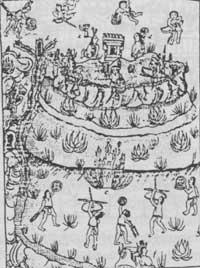
- Both have their guide. Jews, MOISE and Aztecarras in TEKPALTZI. He will tell you at all times what to do and will be God's substitute before His people and any other people.
- Yahve speaks to Moise through a constantly burning lar on Mount Sinai. Huitziloptxtli sings through the mouth of a bird and Tekpaltzine plays his song for Aztdakar.
- Yahweh appears in the eyes of the Jews as a cloud of day and as a cloud of fire of night. Huitziloptxtli pretends to be a white eagle to run his village.
- The Jews build a Tent of Meetings to talk to Yahweh. When I was going to talk to Moise Yahve, the cloud went down and stopped at the entrance and Yahve spoke to Moise. (Exodus 33.3). Aztecs: Only when you see me and when my brightness goes out, rest. That will be my sign and there you will build my temple.
- Yahve constantly demonstrates the will of his people by relying on miracles. In Aztec mythology only one test appears: God dedicated two sacks to his seven lineages: one of them is full of wood and the other of precious stones. The lineages that choose wood will be the fastest, since the wood of this sac serves to build tents, weaving, light fire, etc. Therefore, these lineages will benefit God, and after this trial the initial seven lineages were dispersed.
- The Aztecs say that in their mythology they stopped in the city of TOS and were at ease, but it was not the land that their God offered them and they had to resume their journey. The Jews also had longer or shorter rest periods until they reached the Jordan River, as in Mount HOREB and in the village of KADES, but they did not remain for long.
- Yahweh was a warrior and cruel God. Mois, after conquering the Red Sea, sings to Yahweh: Yahve is a mighty warrior named Yahweh. He ruined Pharaoh's chariots and his army in the sea. ... your arm is Yahweh, glorious in vigor; with your arm, Yahweh, the enemy goes to the ground (Exodus 15:3-7).
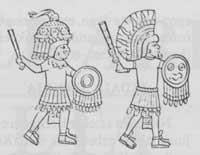
While Egypton lived, it seems that he was a stationary and peaceful people, but as the Exodus progressed, Mois organized his People “militarily” with the “centuria and militia” system. That is why, even though Israeli victories were not as prestigious as those of the Empire, their military forces and abilities should be taken into account. As mentioned in the Bible, about 60 towns or cities were won or dominated. Yahve told the Israelis to destroy all the idolatrous peoples they found using ANATEMA, that is, they should kill children, women and men, as well as all animals. There was no forgiveness. Therefore, Yahweh, as we have said, appears in most cases as a warrior and cruel God, who chooses his country as Holy.
Huitziloptxtli: He was God of the Sun, that is, God creative and prolific, but also warrior. The villages of Aztdakar were initially mercenary and the Toltecs, their ancestors, enjoyed the fame of the uncontrollable and ferocious gudaris.
9. All peoples offer something to their Gods. At the arrival of the Spanish conquerors, the people of Aztdakar offered the hearts and blood of the people to their God Major to keep him alive. This has been the “sin” that has always been accused of. Apart from sins, we must bear in mind that this custom was quite new in the history of this country: It began at the time of the sixth Aztec king, and its ancestor was the Toltec people, who offered not human life to the same God, but flowers, butterflies and snakes. The Jews on the altar killed the animals as an offering and wanted to reassure God Yahweh with his blood. 10. On the other hand, it can be said that it is not possible to compare the exact and prosperous data offered by the Holy Bible with the mythological history of a oral nature. If the Bible gives in writing a social and moral organization and not the mythology of the Aztec people, that does not mean that the latter did not have it, because it is well demonstrated that the Spaniards came to the New World (and especially to the heart of the Aztecs) and were surprised at their organization and wisdom. Writing was represented by drawings, to fix mathematical codes, days and months. Society was staggered by professions. The architectural constructions, the water pipes, the bridges and the roads that they used to communicate the main village that was in the center of a lake, taught them as advanced peoples.
Therefore, if we remain in the skin of these symbols, we will not cause anything equivalent, but these two Peoples essentially as far away (as with many others), with their Gods, rites and beliefs, show us that they perform the same or similar functions and, ultimately, the fears and desires of any human being are conditioned by the environment offered by the place of residence.
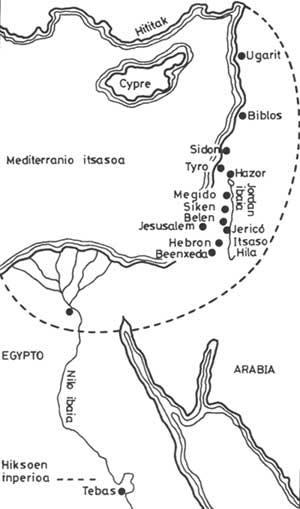

Gai honi buruzko eduki gehiago
Elhuyarrek garatutako teknologia



